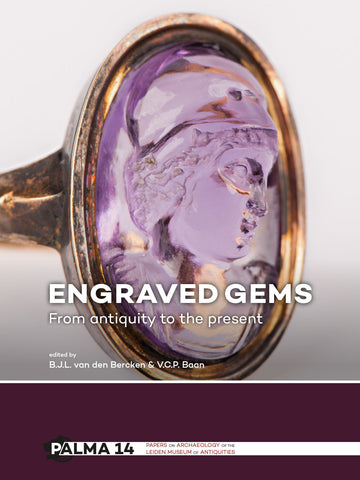Engraved Gems, From Antiquity to the Present
50,00 $
ISBN: 9789088905056
Description: softcover, 182 pp. (28x21cm) figs.
Condition: new
Weight: 645g.
Engraved Gems, From Antiquity to the Present, edited by Ben van den Bercken, Vivian Baan, Papers on Archaeology of the Leiden Museum of Antiquities 14, Sidestone Press, Leiden 2017
Many are no larger than a fingertip. They are engraved with symbols, magic spells and images of gods, animals and emperors. These stones were used for various purposes. The earliest ones served as seals for making impressions in soft materials. Later engraved gems were worn or carried as personal ornaments – usually rings, but sometimes talismans or amulets. The exquisite engraved designs were thought to imbue the gems with special powers. For example, the gods and rituals depicted on cylinder seals from Mesopotamia were thought to protect property and to lend force to agreements marked with the seals.
This edited volume discusses some of the finest and most exceptional precious and semi-precious stones from the collection of the Dutch National Museum of Antiquities – more than 5.800 engraved gems from the ancient Near East, Egypt, the classical world, renaissance and 17th-20th centuries – and other special collections throughout Europe. Meet the people behind engraved gems: gem engravers, the people that used the gems, the people that re-used them and above all the gem collectors. This is the first major publication on engraved gems in the collection of the National Museum of Antiquities in Leiden since 1978.
Preface
Wim Weijland, director Rijksmuseum van Oudheden
Introduction
Ben van den Bercken (assistant curator Engraved Gems, Rijksmuseum van Oudheden, Leiden)
1. Roman Gems in Old Collections and in Modern Archaeology
Martin Henig (member of the Faculty of Classics, University of Oxford/honorary professor, University College London)
2. Cassandra on Seals. Ring Stone Images as Self-Representation: an Example
Marianne Kleibrink (professor emeritus Classical and Mediterranean Archaeology, Groningen University)
3. Some Cameos in Leiden – Roman to Neoclassicism
Gertrud Platz-Horster (former vice director Antikensammlung, Staatliche Museen zu Berlin)
4. The Original RMO Engraved Gem Collection: Gem Identification and Applied Research Techniques
Hanco Zwaan and Christine Swaving (Naturalis Biodiversity Center/Netherlands Gemmological Laboratory, Leiden)
5. An Important Collection of Mesopotamian Cylinder Seals.
Diederik J.W. Meijer (associate professor Near Eastern Archaeology, Leiden University)
6. Sasanian Seals: Owners and Re-users
Rika Gyselen (research director emeritus CNRS, Iranian and Indian World)
7. Invocations to Hermes and Aphrodite on Two Engraved Gems in Leiden
Attilio Mastrocinque (professor of Roman history, University of Verona)
8. The Importance of Gems in the Work of Peter Paul Rubens 1577-1640
Marcia Pointon (professor emeritus in History of Art, University of Manchester)
9. Post-Classical Cameos, their Makers and Users
Claudia Wagner (senior research lecturer at Lady Margaret Hall, University of Oxford)
10. Princely Splendour: Some Cameo Vessels from the Middle of the Seventeenth Century and their Patrons
Jørgen Hein (senior curator of the Royal Danish Collection at Rosenborg Castle, Copenhagen)
11. “A Treasure, a Schoolmaster, a Pass-Time” Dactyliothecae in the 18th and 19th Centuries and their Function as Teaching Aids in Schools and Universities
Valentin Kockel (professor emeritus for Classical Archaeology, University of Augsburg)
12. Non Grylloi, Baskania Sunt. On the Significance of the So Called Grylloi/Grilli or Grylli in Greek and Roman Glyptics
Carina Weiss, (independent researcher, Archaeological Institute of the University of Würzburg)
13. Another Perspective on the So Called Grylloi
Selkit Verberk (assistant curator Engraved Gems, Rijksmuseum van Oudheden, Leiden)
14. Some Unpublished Scarabs from the Leiden Collection
Ben van den Bercken (assistant curator Engraved Gems, Rijksmuseum van Oudheden, Leiden)

